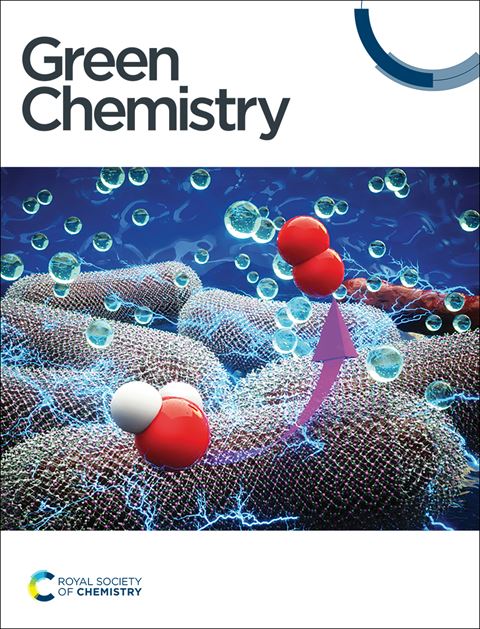基于流化焙烧的硫化改造浮选菱锌矿
IF 9.3
1区 化学
Q1 CHEMISTRY, MULTIDISCIPLINARY
引用次数: 0
摘要
随着我国硫化锌矿石储量的不断减少,对难选氧化锌矿石中氧化锌矿物的选择性分离提出了前所未有的迫切需求。铁矿作为一种典型的氧化锌资源,在浮选预富集前需进行硫化处理以增强其疏水性。本文提出了一种基于流态化焙烧的硫化改造工艺来处理菱锌矿。通过浮选试验验证了硫化焙烧的可行性。通过优化焙烧和浮选条件,以丁基黄药(BX)为捕收剂,在250 vol% H2气氛下,450℃焙烧20 min,浮选回收率达到89%。焙烧产物的表面性质表征表明,焙烧温度对硫化产物的矿物相组成起关键作用。具体来说,在450℃的焙烧温度下,一层疏水闪锌矿覆盖在smithsonite表面,而在750℃的焙烧温度下,硫化物产物主要由亲水性纤锌矿组成。此外,与传统的Na2S处理或硫化焙烧相比,在25 vol% H2气氛下进行的流态化硫化焙烧显著降低了焙烧温度。这一创新工艺不仅减少了有毒SO2气体的产生,而且还产生了更多的疏水性smithsonite,从而减少了捕收剂的用量。研究表明,基于流态化焙烧的硫化改造是处理氧化锌矿石的一种很有前途的工艺,为传统工艺提供了一种高效、环保的替代方法。本文章由计算机程序翻译,如有差异,请以英文原文为准。
Efficient flotation of smithsonite using sulfidation reconstruction based on fluidization roasting†
There is an urgent and unprecedented demand for the selective separation of zinc oxide minerals from refractory zinc oxide ores due to declining reserves of zinc sulfide ores. Smithsonite, as a typical zinc oxide resource, requires sulfidation to enhance its hydrophobicity prior to flotation pre-enrichment. In this paper, a sulfidation reconstruction based on fluidization roasting is proposed to treat smithsonite. Flotation experiments were conducted to demonstrate the feasibility of sulfidation roasting. By optimizing the roasting and flotation conditions, a remarkable flotation recovery of 89% was achieved using butyl xanthate (BX) as the collector, following a 20 minute roasting at 450 °C under a 25 vol% H2 atmosphere. Characterization of the surface properties of the roasted products revealed that the roasting temperature plays a pivotal role in determining the mineral phase composition of the sulfide products. Specifically, a hydrophobic layer of sphalerite coats the surface of smithsonite at a roasting temperature of 450 °C, while the sulfide products primarily consist of hydrophilic wurtzite at a roasting temperature of 750 °C. Additionally, when compared to conventional Na2S treatment or sulfidation roasting, fluidization sulfidation roasting conducted under a 25 vol% H2 atmosphere significantly lowers the roasting temperature. This innovative process not only reduces the generation of toxic SO2 gas but also produces more hydrophobic smithsonite, thereby reducing the dosage of collectors. Our study suggests that the sulfidation reconstruction based on fluidization roasting is a promising process for treating zinc oxide ores, offering a highly effective and environmentally benign alternative to the conventional process.
求助全文
通过发布文献求助,成功后即可免费获取论文全文。
去求助
来源期刊

Green Chemistry
化学-化学综合
CiteScore
16.10
自引率
7.10%
发文量
677
审稿时长
1.4 months
期刊介绍:
Green Chemistry is a journal that provides a unique forum for the publication of innovative research on the development of alternative green and sustainable technologies. The scope of Green Chemistry is based on the definition proposed by Anastas and Warner (Green Chemistry: Theory and Practice, P T Anastas and J C Warner, Oxford University Press, Oxford, 1998), which defines green chemistry as the utilisation of a set of principles that reduces or eliminates the use or generation of hazardous substances in the design, manufacture and application of chemical products. Green Chemistry aims to reduce the environmental impact of the chemical enterprise by developing a technology base that is inherently non-toxic to living things and the environment. The journal welcomes submissions on all aspects of research relating to this endeavor and publishes original and significant cutting-edge research that is likely to be of wide general appeal. For a work to be published, it must present a significant advance in green chemistry, including a comparison with existing methods and a demonstration of advantages over those methods.
 求助内容:
求助内容: 应助结果提醒方式:
应助结果提醒方式:


